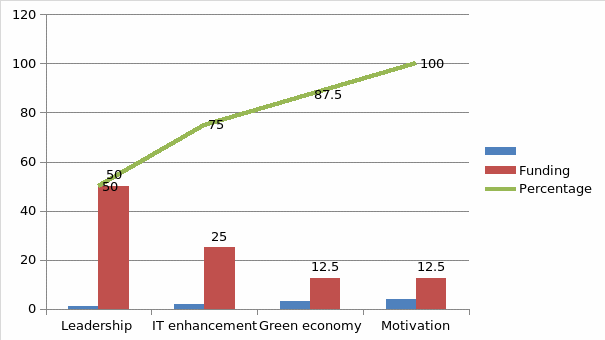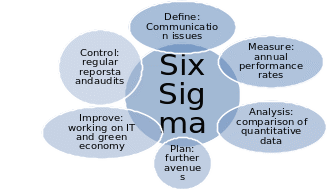DHL Express has gained an impressive reputation over the past few decades by providing transportation services of outstanding quality. According to the mission and vision of the organisation, the company is aimed at becoming the household name for logistics in general: “Our vision stresses that we want to be the logistics provider people turn to – their first choice not only for all their shipping needs, but also as an employee or investor” (Our mission and vision, 2015).
However, in the environment of the 21st-century global market, DHL has faced the necessity to re-evaluate its assets and reconsider its priorities. In order to remain efficient in the global environment, the company will have to promote the concept of green economy in order to make the process of delivery environmentally friendly, update its IT system and redesign the leadership strategy so that the framework of transformative leadership could be established within the organization.
In terms of the workflow improvement, the company will have to reconsider not only its leadership issues, but also the fact that the organization uses an outdated information system. Particularly, it is the inventory issue that affects the workflow on a rather deep level. Despite the fact that the issue has been put into the limelight several times, particularly, in 2007 and 2004 (European printing solution for DHL Global Forwarding, 2008), the situation concerning the use of appropriate technology remains to be solved.
The information concerning the outdated approach towards inventory also points at the issue regarding the use of the company’s financial resources. There is no need to stress the fact that a technologically enhanced approach to data management and consumer relations will trigger a drastic change in the company’s resources allocation. Therefore, the reconsideration of the organisation’s financial strategy needs to be viewed as the first step towards improving the current state of affairs.

As the diagram provided above shows, the DHL Company needs to introduce the approach that will help the company focus on the IT issues and the enhancement of its environmental strategy, including the primary need concerning the information transfer. Sd the check sheet provided below shows, DHL will have to work towards enhancement of its leadership model, which will allow for creating a sustainable approach towards the use of natural resources
Chart 2. Check Sheet
The check sheet provided above sets the company aside from a range of other organizations, as it displays the organization’s readiness to address the current issues, particularly, the issue of green economy, and contributing to the improvement of the environmental situation. Moreover, the check sheet offered above proves that the organization has a detailed plan on improving its mode of operation.
The current allocation of the organisation’s resources does seem reasonable, as the company clearly abuses the resources that it has at its disposal at present. Additionally, the update of the IT system used in the organization is quite clear based on the chart provided above. Finally, the change of the leadership strategy towards the transformative one is likely to affect the motivation rates among the staff and, therefore, increase the overall performance rates of the organization.

As the diagram provided above shows, it is crucial that the organization should consider funding the development of a more efficient leadership strategy. Despite the fact that the promotion of green economy seems the organization’s top priority at present, it is the manner of making important decisions that defines the company’s future now.
The reasons for the improvement of the specified domains are obvious. First and most important, the quality of the technology used in the course of services delivery will promote higher quality rates and, therefore, increased rates of customer satisfaction. Secondly, the improvement of the framework of relationships between the staff and the company’s managers will enhance the motivation rates among the employees. Finally, the reconsideration of the environmental strategy adopted by the DHL Organisation will provide.
It should be born in mind that the approach adopted within the company should be structured in alignment with the core competencies that the organization can be distinguished with. Specifically, the competencies such as personal devotion of the staff, the proactive solutions and the worldwide locxal strength deserve to be mentioned.
In order to improve the management process within the organisation and promote better relationships between the employees and the staff, the Six Sigma approach was chosen. According to the official definition of the strategy, Six Sigma is a “business strategy used to improve business profitability, to improve the effectiveness and efficiency of all operations to meet or exceed customer’s needs and expectations” (Kwak & Anbari, 2004, p. 2). The diagram below displays the effects of adopting the Six Sigma model to the framework of the DHL organisation.

As displayed in Diagram 2, the organisation needs not only carrying out the changes mentioned above in a manner as expeditious as possible, but could also use the redesign of its leadership strategy. The latter, in fact, can be viewed as the primary tool for boosting the motivation rates among the staff. The transformative leadership style can be used as the tool for redesigning the staff’s motivation and getting the employees’ priorities straight.
As ti has been stressed above, the organization is facing major issues with three key workflows, i.e., the absence of green delivery of the end product, the lack of an appropriate leadership model and the necessity to update the current IT system. It is quite remarkable that the suggested approach will also lead to a major enhancement in the services quality; specifically, the information flow will be enhanced, which will trigger a drop in the number and length of delays, therefore, affecting customers’ perception of the DHL services. This is the point, at which leadership factors of top management need to be brought up.
Seeing that changes in the leadership approach are inevitable and, more importantly, crucial in the specified design to the success of the implementation of the new approaches towards customers and data management, it is imperative that the appropriate leadership model should be integrated into the company’s framework. Therefore, the key tenets of the leadership factors of top management need to be revisited. The model in question, in fact, supports the idea of altering the relationships between managers and employees, as well as the reconsideration of the role of employees in the company, by promoting the proper behavioural patterns to the staff through the introduction of the appropriate role model, which the leader is going to represent and which the staff is supposed to follow. Additionally, the model suggested above puts a very strong emphasis on knowledge in accordance with the model in question, therefore, promoting trust among the company members.
Finally, the paradigm under consideration provides a very distinct focus of the further changes, i.e., the overall enhancement of the production process through the enhancement of information management and the redesign of the organisational behaviour for both the staff and the managers. Thus, it can be assumed that the model to be adopted in the context of the DHL organisation aligns with the key tenets of the leadership factors approach (De Hoogh, Hartog & Koopman, 2007).
As a result of improved manager– employee relationships and the alterations made to the current data processing framework, the organisation will be capable of responding to the needs of the clients in a more adequate and expeditious manner. The enhancement of the staff’s role in the company’s operations will, in its turn, contribute to a major boost in the individual productivity of the staff members and the overall performance of the company. As a result, a major boost in quality of the services provided will be carried out.
There is no need to stress the fact that the quality of the services will have to be checked regularly. The specified change to the organisation’s operations is crucial for maintaining the organisation’s reputation in the target market and improving customer relationships (Jennex, 2010). Thus, it will be necessary to consider the adoption of weekly audits for checking the quality of the transportation process, including the time that it takes, the arrangements that are made prior to the products transfer, the efficacy of the information processing tools, the responsiveness of the staff, etc. In addition to the above-mentioned tool, the incorporation of daily reports into the staff’s routine will have to be considered.
While weekly audits will facilitate a detailed analysis of the overall performance of the organisation, these are the daily reports that will help notice a problem at the earliest stages of its development and even suggest the methods of addressing it. The specified innovation is especially significant for the enhancement of the financial department’s operations.
Therefore, based on the issues detected above, three key tools for enhancing the company’s operations can be suggested, i.e., the reconsideration of the firm’s budget and the provision of financial resources for a technological update of DHL, the change in the leadership approach and the incorporation of weekly and daily checks into the mechanism of the financial department’s operations. As far as the tools allowing for galvanising the process of decision making are concerned, various negotiation techniques, which help focus on locating the compromise in meeting the needs of the key stakeholders deserves to be viewed as an option. To be more exact, the principle of collaboration as the foundation for negotiating between the company stakeholders should be brought up (Dima & Vlăduţescu, 2012).
In order to measure the progress that the above-mentioned strategies will supposedly have on the DHL Company’s performance, the aforementioned Sis Sigma approach can be viewed as a means to assess the overall performance of the organisation. By quantifying the results of the assessment and comparing them to the outcomes of the evaluation provided above, one will be able to define the progress made by DHL and suggest further avenues for improving the company’s evolution.
Apart from the measurements discussed above, the company will have to consider the measurements that are related to the process of communicating with its suppliers. For these purposes, the creation of employee communities and the design and analysis of regular surveys will have to be viewed as an option.
Despite the fact that the DHL organisation has been doing comparatively well over the past decade, the issues concerning the lack of innovations in the technology used by the company, as well as the communication principles that leave much to be desired in terms of both customer feedback and information management within the company, needs a closer attention. By reducing the costs for the transportation and the related issues, the organisation might be able to enhance its communication system and invest into the development of a flexible system of feedback gathering. Additionally, collecting feedback from the staff is imperative for the further enhancement of the company’s operations and its overall performance.
The specified objective, in its turn, can be attained by promoting a new model of organisational behaviour based on the principles of corporate social responsibility and total quality management among the staff. The issues regarding the lack of motivation among the staff, in their turn, can be addressed by developing an elaborate model of organisational behaviour for the staff to comply with, as well as the reconsideration of the corporate values towards a more stakeholder focused approach; thus, the needs of the staff will be met within a relatively short amount of time and DHL’s efficacy will rise significantly.
Reference List
De Hoogh, A. H. B., Hartog, D. N. D. & Koopman, A. P. L. (2007). Linking the Big Five-Factors of personality to charismatic and transactional leadership; perceived dynamic work environment as a moderator. California Management Review, 47(1), 839–865. Web.
Dima, J. C. & Vlăduţescu, D. S. (2012). Persuasive communication in logistic negotiation. International Journal of Eco Research, 3(1), 14–23. Web.
European printing solution for DHL Global Forwarding. (2008). Web.
Jennex, M. E. (2010). Strategies for knowledge management success: Exploring organisational efficacy: exploring organisational efficacy. New York, NY: IGI Global. Web.
Our mission and vision. (2015). Web.
Kwak, Y. H. & Anbari, N T. (2004). Benefits, obstacles, and future of six sigma approach. Technovision, 1(1), 1–8. Web.